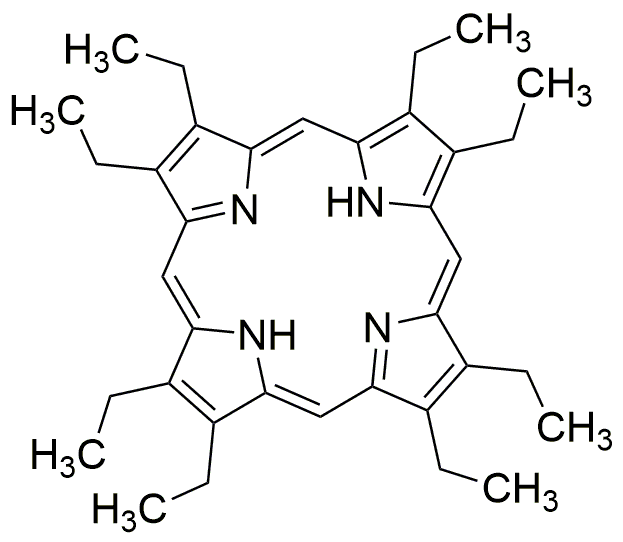2,3,7,8,12,13,17,18-Octaethylporphyrin is widely utilized in research focused on:
- Photodynamic Therapy: This compound is used in cancer treatment, where it acts as a photosensitizer. When exposed to light, it generates reactive oxygen species that can destroy cancer cells, making it a valuable tool in targeted therapy.
- Solar Energy Conversion: Its unique structure allows it to efficiently absorb sunlight, making it an excellent candidate for use in solar cells. Researchers are exploring its potential to enhance the efficiency of photovoltaic devices.
- Biochemical Sensors: The compound can be incorporated into sensors for detecting various biomolecules. Its ability to change properties in response to environmental changes makes it useful in medical diagnostics and environmental monitoring.
- Organic Electronics: It is being studied for applications in organic light-emitting diodes (OLEDs) and organic photovoltaics, where its electronic properties can improve device performance and stability.
- Catalysis: The compound shows promise as a catalyst in various chemical reactions, particularly in organic synthesis. Its unique porphyrin structure can facilitate reactions that are challenging with traditional catalysts.
General Information
Properties
Safety and Regulations
Applications
2,3,7,8,12,13,17,18-Octaethylporphyrin is widely utilized in research focused on:
- Photodynamic Therapy: This compound is used in cancer treatment, where it acts as a photosensitizer. When exposed to light, it generates reactive oxygen species that can destroy cancer cells, making it a valuable tool in targeted therapy.
- Solar Energy Conversion: Its unique structure allows it to efficiently absorb sunlight, making it an excellent candidate for use in solar cells. Researchers are exploring its potential to enhance the efficiency of photovoltaic devices.
- Biochemical Sensors: The compound can be incorporated into sensors for detecting various biomolecules. Its ability to change properties in response to environmental changes makes it useful in medical diagnostics and environmental monitoring.
- Organic Electronics: It is being studied for applications in organic light-emitting diodes (OLEDs) and organic photovoltaics, where its electronic properties can improve device performance and stability.
- Catalysis: The compound shows promise as a catalyst in various chemical reactions, particularly in organic synthesis. Its unique porphyrin structure can facilitate reactions that are challenging with traditional catalysts.
Documents
Safety Data Sheets (SDS)
The SDS provides comprehensive safety information on handling, storage, and disposal of the product.
Product Specification (PS)
The PS provides a comprehensive breakdown of the product’s properties, including chemical composition, physical state, purity, and storage requirements. It also details acceptable quality ranges and the product's intended applications.
Certificates of Analysis (COA)
Search for Certificates of Analysis (COA) by entering the products Lot Number. Lot and Batch Numbers can be found on a product’s label following the words ‘Lot’ or ‘Batch’.
*Catalog Number
*Lot Number
Certificates Of Origin (COO)
This COO confirms the country where the product was manufactured, and also details the materials and components used in it and whether it is derived from natural, synthetic, or other specific sources. This certificate may be required for customs, trade, and regulatory compliance.
*Catalog Number
*Lot Number
Safety Data Sheets (SDS)
The SDS provides comprehensive safety information on handling, storage, and disposal of the product.
DownloadProduct Specification (PS)
The PS provides a comprehensive breakdown of the product’s properties, including chemical composition, physical state, purity, and storage requirements. It also details acceptable quality ranges and the product's intended applications.
DownloadCertificates of Analysis (COA)
Search for Certificates of Analysis (COA) by entering the products Lot Number. Lot and Batch Numbers can be found on a product’s label following the words ‘Lot’ or ‘Batch’.
*Catalog Number
*Lot Number
Certificates Of Origin (COO)
This COO confirms the country where the product was manufactured, and also details the materials and components used in it and whether it is derived from natural, synthetic, or other specific sources. This certificate may be required for customs, trade, and regulatory compliance.


